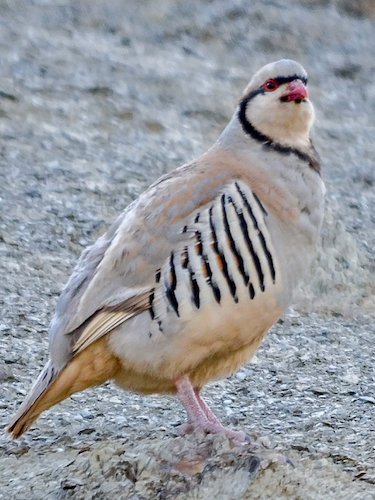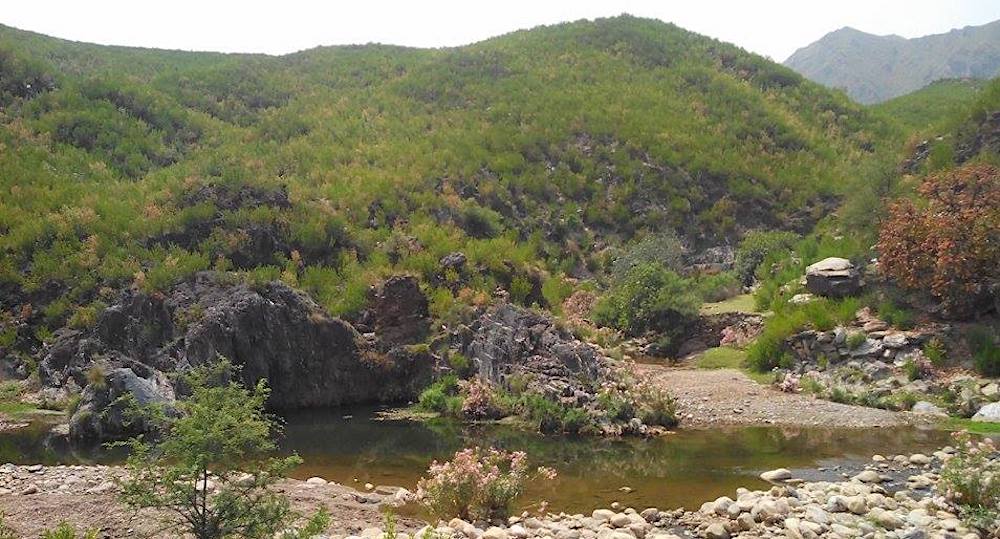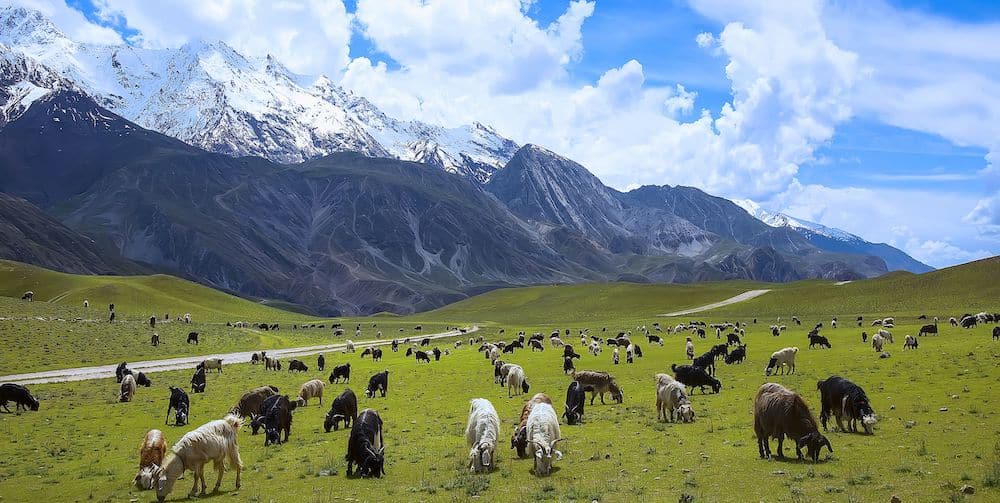Islamic Republic of Pakistan

Pakistan is a country in South Asia. It is the world’s sixth-most populous country with a population exceeding 245 million people. In area, it is the 33rd-largest country, spanning just under 882,000 square kilometres (c.340,000 square miles). Pakistan has a 1,046-kilometre (650-mile) coast line along the Arabian Sea and Gulf of Oman in the south and is bordered by India to the east, Afghanistan to the west, Iran to the southwest, and China in the far northeast. It is separated narrowly from Tajikistan by Afghanistan’s Wakhan Corridor in the northwest, and also shares a maritime border with Oman.
Pakistan is divided into three major geographic areas: the northern highlands, the Indus River plain, and the Balochistan Plateau. The northern highlands contain the Karakoram, Hindu Kush, and Pamir mountain ranges, which contain some of the world’s highest peaks.

Baluchistan xeric woodlands – ©Sohail.awkum, CC BY-SA 3.0 via Wikimedia Commons
The Balochistan Plateau lies in the west and the Thar Desert in the east. The 1,600 km (1,000 mile) Indus River and its tributaries flow through the country from the Kashmir region to the Arabian Sea. There is an expanse of alluvial plains along it in the Punjab and Sindh. It is a country with a diverse wildlife in its Indus valley plains, fresh water lakes, ice-capped mountains, deserts, plateaus, and its 1000 km coastline. There is a wide variety of bird species in the region.
Birding Pakistan
Pakistan is not well equipped for birding activities in general. There are no regularly planned birding tours. The sites below are recommended for safe birding activities.
The climate varies from tropical to temperate, with arid conditions in the coastal south. There is a monsoon season with frequent flooding due to heavy rainfall, and a dry season with significantly less rainfall or none at all. There are four distinct seasons in Pakistan: a cool, dry winter from December through February; a hot, dry spring from March through May; the summer rainy season, or southwest monsoon period, from June through September; and the retreating monsoon period of October and November.
The ideal bird watching season is winter when a wide variety of birds visit the wetlands and planes of Pakistan from Siberia. However, during summer the high-altitude mountain areas (from 5,000m to 8,000m) of Northern Pakistan can be visited for watching unique species of resident birds.

Chitral National Park – ©Tahsin A Shah, CC BY-SA 4.0 via Wikimedia Commons
Productive areas include: Chitral National Park, Gilgit Valley, Biltistan, Khunjrab National Park, Hunza Valley and Nanga Parbat tracking area. There are ample facilities for bird watching tourists in these areas.
Some other important areas are, among others: Chiltan National Park at Hazar Ganji, Ayubia National Park, Doesai National Park, and Kirthar National Park.
-
Hadero Lake
InformationSatellite ViewHadeiro Lake is situated 5 km north of Haleji. It is a small lake famous for pelicans and flamingos. -
Haleji Lake
InformationSatellite ViewIt is Asia's greatest waterfowl reserve. Haleji lake is situated about 70km from Karachi. During winter thousands of birds fly down to Haleji from Siberian colder areas. It is the largest bird sanctuary of Pakistan. -
Kinjhar Lake
InformationSatellite ViewKinjhar Lake is the largest fresh water lake of Pakistan. It is situated further 50km from Haleji near 2,500 years old civilization of Makli, Thatta and Bhambhore. It houses variety of tourist huts and boating facilities. -
Lal Suhanra National Park
InformationSatellite ViewThis Park is situated in Choolistan desert about 40km from Bahawalpur. It is a nice place for watching desert species. It houses tourists huts and watch towers. -
Mai-Kolachi by-pass
Satellite ViewThis by-pass road is situated right in he heart of Karachi near 5-Star hotel complex off M T Khan road. It is a unique spot for watching flamingos in sea lagoons across the road even on a very short trip to Karachi. -
Margalla Hills National Park
InformationSatellite ViewMargalla hills form the skyline of Islamabad. There are a variety of resident birds which can be seen there during a normal jogging trip on the hills or on a special birding trip. -
Rawal Lake & Shakar Parian National Park
InformationSatellite ViewVisitors to the lush green capital of Pakistan can enjoy birding in and around Rawal Lake area in the heart of Islamabad. It is famous for resident as well as visiting birds. -
Ucchali Lake Complex
InformationSatellite ViewUcchali Lake Complex consists of three small lakes. It is situated in the salt range plateaus in north-central Punjab. This area is famous for the regular winter visitor white-headed duck Oxyura Leucocephala.
-
Number of bird species: 792
(As at June 2024)National Bird: Chukar Partridge Alectoris chukar
-
Avibase
PDF ChecklistThis checklist includes all bird species found in Pakistan , based on the best information available at this time. It is based on a wide variety of sources that I collated over many years. I am pleased to offer these checklists as a service to birdwatchers. If you find any error, please do not hesitate to report them. -
Bubo
ChecklistThe Pakistan checklist is based on the Oriental Bird Club list for the Oriental region. An appropriate subset of this list is used, based largely on the distribution and status data provided by Avibase and Birds of South Asia1. Note that this list is not official and may have some errors (although hopefully less than other published lists for this location!). If you notice any omissions or errors then please let us know. -
Wikipedia
Annotated ListThis is a list of the bird species recorded in Pakistan. The avifauna of Pakistan include a total of 792 species. The chukar (Alectoris chukar) is the official national bird of Pakistan, and the shaheen falcon is the symbolic icon of the Pakistan Air Force and Pakistan Avicultural Foundation, one bird is endemic. -
eBird
PDF Checklist630 species (+99 other taxa) - Year-round, All years
-
A Field Guide to Birds of the Indian Subcontinent
| By Krys Kazmierczak & Ber van Perlo | Christopher Helm | 2008 | Paperback | 352 pages, 96 colour plates, b/w illustrations, distribution maps | Out of Print | ISBN: 9781408109786 Buy this book from NHBS.com -
A Naturalist's Guide to the Birds of India Bangladesh, Bhutan, Nepal, Pakistan and Sri Lanka
| By Bikram Grewal & Garima Bhatia | John Beaufoy Publishing | Edition 2 | 2022 | 176 pages, 300+ colour photos, 1 colour map | ISBN: 9781913679347 Buy this book from NHBS.com -
A Photographic Field Guide to the Birds of India, Pakistan, Nepal, Bhutan, Sri Lanka, and Bangladesh
| By Bikram Grewal & Sumit Sen | Princeton University Press | 2017 | Paperback | 792 pages, 4000+ colour photos, 1300+ colour distribution maps | ISBN: 9780691176499 Buy this book from NHBS.com -
Birds of Pakistan
| By Richard Grimmett, Tom Roberts & Tim Inskipp | Christopher Helm | 2009 | Paperback | 256 pages, colour plates throughout | ISBN: 9780713688009 Buy this book from NHBS.com

Indian Birds
Apple iOS | AndroidIntroducing Indian Birds, the time-honored and cherished birding companion for India. Established in 2010, it proudly remains the sole mobile app available on the Google Play Store, offering bird enthusiasts the ability to explore bird names in numerous regional Indian languages. Indian Birds is your guide to the avian world, supporting Marathi, Hindi, Sanskrit, Gujarati, Bengali, Kannada, Assamese, Bhojpuri, Nepali, Malayalam, Tamil, Punjabi, Oriya, and Telugu. Unveil the ultimate field guide with Indian Birds, providing valuable insights such as bird size, sexual distinctions...Organisations-
BRC Bird Watching club, Pakistan
Facebook PageBioresource Research Centre organized Bird Watching Club. -
Birds of Pakistan
Twitter PageTweet birdlife of Pakistan for awareness, popularizing birding & highlight threats to them. -
Ornithological Society of Pakistan
WebsiteBlock D Near Farawa Chowk, PO Box 73, Dera Ohazi Khan, 32200. + 92 641 62339osp@mul.paknet.com.pk
Reserves-
*Protected areas of Pakistan
InformationSatellite ViewAs of present, there are around 157 protected areas in Pakistan that are recognised by IUCN. -
NP Ayubia
InformationSatellite ViewAyubia National Park is a protected area of 3,312 hectares (33 km2)[1] located in Abbotabad District, Khyber Pakhtunkhwa province, Pakistan. The park harbors up to 203 species of birds. Many species of birds, including the golden eagle, the vulture, Eurasian sparrowhawk and the hill pigeon among others can be found here. It is also home to some of the rarer Himalayan pheasant species like the kalij and koklass pheasants. Ayubia National Park supports 31 species of mammals such as the Asiatic leopard, hill fox and flying squirrel. -
NP Central Karakoram
InformationSatellite Viewit covers an area of about 10,000 sq. km and contains the greatest concentration of high mountains on earth. The number of bird species present is low. The robin accentor (Prunella rubeuloides) and black-throated thrush (Turdus ruficollis) overwinter here, and vultures, birds of prey, rosefinches (Carpodacus spp.), Himalayan monals (Lophophorus impejanus) and Güldenstädt's redstarts (Phoenicurus erythrogaster) remain throughout the year, though they may move to somewhat lower elevations in winter. -
NP Hazarganji-Chiltan
InformationSatellite ViewHazarganji Chiltan National Park is a national park in the Mastung District of western Balochistan Province of Pakistan. It lies between Chiltan on its west and Hazarganji on the east. The park was established in 1980 to provide the habitat to rare Chiltan ibexes found in the area. 120 species of avifauna (36 resident and 84 migratory) and 30 species of reptiles. Birds includes the very rare Houbara bustard, griffon vulture, Egyptian vulture, crested honey buzzard (winters only), laggar falcon, peregrine falcon, common kestrel, Eurasian sparrowhawk (winters only), Indian scops owl, Indian cuckoo, European bee-eater (breeding only), chukar partridge, European nightjar (breeding/summer only), long-billed pipit, Eastern Orphean warbler, variable wheatear, blue rock thrush, whinchat, white-browed bush chat and Lichtenstein's desert finch. -
NP Kirthar
InformationSatellite ViewIt tretches over 3,087 square kilometres (1,192 sq mi), making it the second largest national park in Pakistan after Hingol National Park. The fauna comprises Indian leopards, striped hyenas, Indian wolves, ratels, urials, chinkara gazelles and rare Sind wild goats. Blackbuck antelopes are kept in enclosures for a reintroduction project at Kirthar National Park. Most large predators have been killed with the last leopard shot in 1977. -
NP Lal Suhanra
InformationSatellite ViewLal Suhanra is a national park in Pakistan that is situated in the Bahawalpur district of Punjab province. It is one of South Asia’s largest nationals parks, and is a UNESCO declared Biosphere Reserve. More than 160 species of birds are also present, including the houbara bustard, griffon vulture, crested honey buzzard, marsh harrier, hen harrier, laggar falcon, peregrine falcon, kestrel, Eurasian sparrowhawk, Egyptian vulture, lark, shrike, wheatear, and barn owl. Lake Patisar, a large body of water in the center of the park, is ideal for bird watching. In mid-winter, the lake is regularly home to between 10,000 and 30,000 ducks and common coot. -
NP Margalla Hills
InformationSatellite ViewIt is a national park located in Islamabad Capital Territory. It covers approximately 17,386 hectares (67.13 sq mi). Tilla Charouni with a height of 1604m is tallest peak in the park. The park is rich in biodiversity, especially rich in Sino-Himalayan fauna, most notably gray goral, barking deer and the Leopard. It is also home to a large number of birds such as larks, paradise flycatcher, black partridge, shrikes pheasants, spotted doves, Egyptian vultures, falcons, hawks and eagles. -
NP Rawal Lake & Shakar Parian
InformationSatellite ViewThe reservoir is of considerable importance for wintering waterfowl. It is a good place for birds watching, as the majority of Birds of Islamabad are found here. -
Pakistans IBAs
PDF ArticleSatellite ViewOverview of IBAs -
WII Jiwani Coastal Wetland
InformationSatellite ViewThe Jiwani Coastal Wetland is a wetland located in Balochistan, Pakistan, near the town of Jiwani. According to the book Avian Diversity of Jiwani Coastal Wetlands, Pakistan, 112 species of birds were recorded of which 79 species were migratory and 33 were resident. Of the 79 migratory species, 54 migrated during winters, 11 migrated during summers, 10 were year round visitors, and 3 species were vagrant. -
WS Haleji Lake
InformationSatellite ViewHaleji Lake is a perennial freshwater lake in Thatta District of Sindh Province, Pakistan. It is 6.58 km2 (2.54 sq mi) in size and is surrounded by marshes and brackish seepage lagoons. Haleji Lake is a wintering site for waterfowl such as cotton teal, spot-billed duck, purple moorhen and pheasant-tailed jacana. It is also a breeding site for egrets and herons. -
WS IBA Chashma Barrage
InformationSatellite ViewA large barrage on the Indus river with a series of embankments or flood bunds which, at low water levels, divide the reservoir into five shallow lakes each of up to 250 ha in area. The construction was completed in 1971. Maximum flooding occurs in spring. -
WS WII IBA Keenjhar Lake
InformationSatellite ViewKeenjhar Lake is in Thatta District, Sindh, Pakistan. It is 122 km from Karachi and 18 km from the town of Thatta. It is the second largest fresh water lake in Pakistan. Keenjhar Lake has been declared a ramsar site and a wildlife sanctuary. It provides a favorable habitat of winter migratory birds like ducks, geese, flamingos, cormorants, waders, herons, egrets, ibises, terns, coots and gulls. It has been observed as a breeding area of the black-crowned night heron, the cotton pygmy goose, purple swamphen, and pheasant-tailed jacana. -
Wetlands
WebpageSatellite ViewPakistan presently has 19 sites designated as Wetlands of International Importance, with a surface area of 1,343,627 hectares…
Sightings, News & Forums-
eBird
Sightings
Guides & Tour Operators-
BirdQuest
Tour OperatorPAKISTAN’S HIMALAYAS – Orange Bullfinch, White-cheeked Bushtit, Long-billed Bush Warbler and other Western Himalayan specialities -
BirdTour Asia
Tour OperatorThis exciting addition to our tours sees us combine Tajikistan and Pakistan in search of some of the regions least-known species. -
Pakistan Travel and Tours
Tour OperatorThere are around 362 bird species all over Gilgit-Baltistan according to birdsofgilgit.com and there is a great variety of waterfowl (up to 86 species), especially during spring and autumn. There are a number of birds of prey such as hawks, eagles, vultures, owls and falcons.
Trip Reports-
2017 [07 July] RMK - - A Journey to the North of Pakistan
ReportAfter having a wonderful birding season during the early months of the year, finding summer birds in Islamabad became difficult due to the heat. So, yours truly, Swabi Birder, decided to undertake a long journey to the see the majestic mountains of the Northern Territories, with the hope of seeing new species of birds to add to my Pakistan Birding List. -
2020 [03 March] -
ReportI found Sindh province and the region around Karachi to have a huge concentration of birds of prey, perhaps largest in the world. -
2023 [06 June] - Andrew Spencer and Josh Beck
PDF Report...we found Sind Woodpecker eventually, having a very cooperative and showy pair. We then hiked back to the car via an alternative trail that Ali and the locals knew, surprisingly finding Indian Pitta in the gallery forest just behind Gulyal as well, a new bird for the reserve and potentially only the second “known” site in PK aside from Margalla Hills, though it must certainly occur more widely...
Other Links-
Birds of Pakistan
Twitter PageSome species accounts and pictures
Blogs-
Birding Islamabad
BLOGI have decided to create a Blog of my birding exploits in and around Islamabad in Pakistan. Probably a little late as I have just recorded my 300th species. Islamabad is a wonderful place to watch birds; situated as it is at the base of the beautiful Margalla Hills and on the migration highways of many species. Each season brings new birds to the areas around the city as others depart. I hope, in some small way, to generate interest in the birds of Islamabad and the surrounding areas…
-
Fatbirder - linking birders worldwide...
Skip to content
